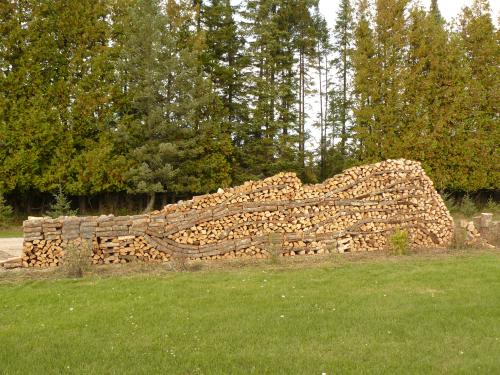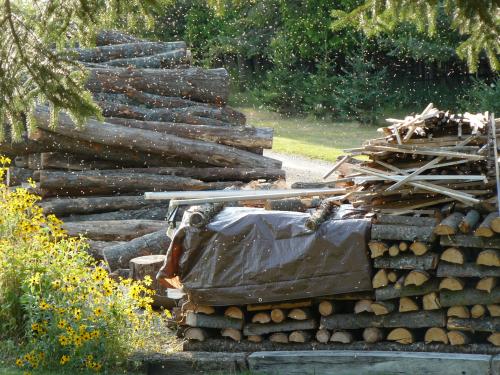Firewood as fuel
Firewood is the oldest source of fuel for heating. For many, it remains the optimum choice for personal use. Well-seasoned wood can be an excellent financial and environmental choice.

Most of us who burn wood have already dug into the winter supply. The snows have fallen and the season has already seen extended sub-freezing periods. Nothing beats the feel of wood heat, but do the costs compete with other fuel sources?
Well, if we have only our own free labor and the expense of a few gallons of gasoline, then wood heat clearly makes financial sense. Not only does it heat the house during the winter but it keeps warm the person doing the cutting and splitting. If you buy cordwood, avoiding the need for a truck and numerous foraging weekends, and then chunk and split it yourself, you are still saving a lot of money.
But what if you have to buy cut and split firewood? How much should you pay if the objective is to heat cheaper than using fossil fuels? The answer depends upon the price of the fuels, species of wood, the type of stove or furnace and wood moisture.
Wood sold by the standard cord is equivalent to a stack of eight foot logs four feet tall and four feet wide. Green weights will be about 4000-5000 pounds per cord, depending upon the species. Dry weights will run 1500-4000 pounds per cord.
Of course, cut and split firewood is not delivered by standard cords, but rather by face cords, which can have any number of volume definitions. However, if we look at standard cord volumes, then we can make some rough calculations.
Hardwood logs being processed into stacked firewood for drying.
Let’s assume fuel oil costs $3.50 per gallon and propane $3 per gallon. If you have a high efficiency wood stove or furnace, you should be able to afford roughly $450 per cord and be ahead money with either fuel oil or propane, or any other fuel for that matter. Home pellet burners are generally cost-competitive with any fossil fuel, even natural gas. If you’re looking to simply feed a wood stove in the living room, the cost might not be as important of an issue as the visual quality of sitting in a comfortable chair next to that fire.
Not all species of firewood are created equal in terms of available heat energy per cord. Remember that a cord is a volume measure, not a weight measure. Pound for pound, the heating value of any species of wood is about the same, roughly 8500 BTUs.
However, most people buy firewood by volume and not by weight or energy unit. Sugar maple, red oak, beech, apple and yellow birch are among the best species from the northwoods. Tamarack, cherry, elm, paper birch, red maple and black ash are intermediate. Pine, fir, spruce, aspen and basswood hold the least amount of energy per cord.
The reason why firewood is better after it is well-dried has to do with the large amount of energy needed to evaporate water. Before wood can burn, it has to be nearly free of water. A fire will drive water out of the wood as steam. That takes energy which would have otherwise been available to heat your room or house. The monetary difference between dry and wet wood can run up to 70-80 percent of the price per cord.

Sometimes creative firewood stacking can be fun.
Additionally, it takes energy to “denature” the solid wood into gases. It’s actually the gases that burn, not the wood itself. It takes energy in the wood to produce the gases. These are the reasons for differences in total BTU values and “available” BTU values. As you might imagine, these sets of values can vary considerably with the condition of wood that you use.
All of these figures and comparisons are generalities because there are many ways to “skin” the home heating cat. Another area with many variables is the efficiency of the heating system. We have everything from the smoky backyard burners to hi-tech heat transfer systems. Some of them probably even work! The upshot with the hi-tech part of the equation is that more heat energy can be captured to heat your house and less is sent out into the cold winter air. Using better quality and well-dried wood will maximize the cost-savings of any system. Scrounging in October for winter wood is bound to produce a supply too wet for efficient burning.
According to Michigan State University Extension, something else to consider these days are the many forest pest problems that can be spread by moving around firewood. The emerald ash borer is most commonly spread by firewood and has been in the news a lot lately. However, pests such as Asian long-horned beetle, oak wilt, beech bark disease and other hitch-hikers also get distributed by firewood movement. Also, there are plenty of “new” exotic pests over the horizon just waiting for careless firewood traffickers. It’s a good idea to develop the habit of burning everything that you cut for the winter before the next growing season.
Lastly, remember to keep safety in mind. Caution with those chainsaws and splitting mauls. Clean the chimneys and maintain the furnaces. Medical bills will eat up everything you might save by heating with wood.



 Print
Print Email
Email



